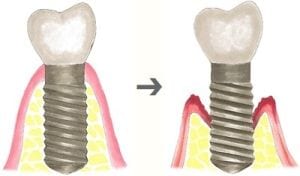Dental Implants are a great move forward in dental health. When first introduced in the 1960's they began a long slow journey into the daily art of dental care. Dental implant have evolved over the decades and are continuing to do so. Cosmetic advances and new materials are having a tremendous impact in people's lives.
Dental Implant are not teeth and a healthy implant will never decay of need root canal treatment.
Dental implants are imbeded in the jawbone and emerge through the gums where bacteria can attack. What we are finding is that a form of gum disease like periodontal disease can have a very detrimental effect on the health of an implant.
proper pre planning of an implant site prior to placement as well as the health and hygiene of the patient are key to success. Dental implants must b meticulously cared for and cleaned along regular dental checkups are essential.
While a patient may be very healthy when an implant is first placed, it is likely that in time a person could develop certain conditions like diabetes and others which may lead to higher incidence of infections and slower healing.
Early diagnosis of implant mucositis (reversable gum inflamation around an implant), or peri-implantitis can lead to a good outcome. Late detection is much more difficult to manage. Loss of an implant, of involved reparative care can be frustrating for the patient.
Peri-implantitis
 |
| healthy implant peri-implantitis |
The following is an excerpt from an article published by the American Association of Periodontology.
Understanding of Their Diagnoses and Clinical Implications*
The American Academy of Periodontology (AAP) periodically publishes reports, statements, and guidelines on a variety of topics relevant to periodontics. These papers are developed by an appointed committee of experts, and the Peri-Implant Mucositis and Peri-Implantitis: A Current
documents are reviewed and approved by the AAP Board of Trustees.
- I. INTRODUCTION – PURPOSE
The use of dental implants has revolutionized the treatment of partially and fully edentulous patients today. Implants have become a treatment approach for managing a broad range of clinical dilemmas due to their high level of predictability and their ability to be used for a wide variety of treatment options. While in many cases dental implants have been reported to achieve long-term success, they are not immune from complications associated with improper treatment planning, surgical and prosthetic execution, material failure, and maintenance. Included in the latter are the biologic complications of peri-implant mucositis and peri-implantitis, inflammatory conditions in the soft and hard tissues at dental implants. It is the purpose of this paper to review the current knowledge concerning peri-implant mucositis and peri-implantitis to aid clinicians in their diagnoses and prevention. It is recognized that new information will continue to emerge, and as such, this document represents a dynamic endeavor that will evolve and require further expansion and reevaluation.
- V. CLINICAL IMPLICATIONS
Peri-implant mucositis and peri-implantitis differ with respect to treatment. To date, evidence suggests that peri-implant mucositis can be successfully treated if detected early and when combined with effective nonsurgical efforts.6,7 Non-surgical therapy has not been shown to be effective for the treatment of peri-implantitis.2,68,72 Currently, different surgical treatment modalities have been proposed and have shown promising results.16,73-77 However, long-term controlled studies are needed to validate which treatment modality may be optimal, given the different clinical scenarios. It has been suggested, as with many inflammatory diseases, that the earlier the diagnosis and intervention, the better the treatment outcome. To that end, routine monitoring of dental implants as a part of a comprehensive periodontal evaluation and maintenance is essential.
To conclude, it is suggested to:
- • Identify risk factors associated with developing peri-implant diseases
- • Establish radiographic baseline at the time of implant placement
- • Establish clinical and radiographic baseline at final prosthesis insertion
- • Employ methods that monitor implant health and determine inflammatory complications as part of an ongoing periodontal maintenance program
- • Establish an early diagnosis and intervention, which will contribute to more effective management of peri-implant diseases
The entire article can be viewed here
https://docs.google.com/viewerng/viewer?url=https://258413772373414384.s3.amazonaws.com/upload/2014/10/2013_JOP_Peri-Implantitis__McAllister.pdf
Your Comments are welcome
Call for an appointment 815 459 2202
visit our website at https://www.crystallakedentalassociates.com/
Phillip C. Neal DDS
Nice Article...
ReplyDeletequickbooks enterprise support phone number
Thanks for sharing this wonderful article on dental implants. The details that you provided explained everything perfectly on bringing a beautiful smile back. Have a great rest of your day and keep up the posts.
ReplyDeleteDentist Philadelphia